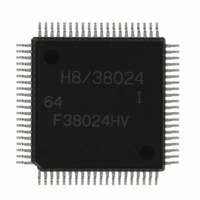HD64F38024DV Renesas Electronics America, HD64F38024DV Datasheet - Page 209

HD64F38024DV
Manufacturer Part Number
HD64F38024DV
Description
IC H8/SLP MCU FLASH 80QFP
Manufacturer
Renesas Electronics America
Series
H8® H8/300L SLPr
Datasheets
1.US38024-BAG1.pdf
(684 pages)
2.DF36012GFYV.pdf
(1021 pages)
3.DF38102HV.pdf
(145 pages)
Specifications of HD64F38024DV
Core Processor
H8/300L
Core Size
8-Bit
Speed
10MHz
Connectivity
SCI
Peripherals
LCD, PWM, WDT
Number Of I /o
51
Program Memory Size
32KB (32K x 8)
Program Memory Type
FLASH
Ram Size
1K x 8
Voltage - Supply (vcc/vdd)
1.8 V ~ 5.5 V
Data Converters
A/D 8x10b
Oscillator Type
Internal
Operating Temperature
-40°C ~ 85°C
Package / Case
80-QFP
Lead Free Status / RoHS Status
Lead free / RoHS Compliant
Eeprom Size
-
Available stocks
Company
Part Number
Manufacturer
Quantity
Price
Company:
Part Number:
HD64F38024DV
Manufacturer:
Renesas Electronics America
Quantity:
10 000
- Current page: 209 of 1021
- Download datasheet (5Mb)
9.2
Here methods for embedding programs into systems employing the H8SX, AE5, H8S/2600,
H8S/2000, H8/300H and H8/300 are explained.
In addition, when using I/O and other C/C++ library functions, the library must be initialized
during preparation of the execution environment. In particular, when using I/O (stdio.h, ios,
streambuf, istream, ostream) and memory allocation (stdlib.h, new), low-level I/O routines and
memory allocation routines must be created.
When using C library functions for program termination (the exit, atexit, abort functions), these
functions must be created separately according to the user system.
In section 9.2.1, the method used to determine addresses for program memory is explained, and
actual examples are used to describe the method for specifying options in the optimizing linkage
editor for determining addresses.
In section 9.2.2, execution environment settings are explained, and an actual example of a program
to set the execution environment is described.
Library function initialization processing, creation of low-level routines, and examples of creation
of functions for termination processing are also explained.
9.2.1
the program must be determined, and these memory areas must be allocated to appropriate
memory addresses.
execution instructions corresponding to functions in the program and data declared using external
data definitions, and areas which are dynamically allocated, such as the stack area. Below,
methods for allocation of each type of area are explained.
To embed a program in a system, the following preparations are necessary.
In order to embed an object program into a system, the size of the memory areas to be used by
Memory areas used by a program include areas which are statically allocated, such as for
Memory allocation
Each section, the stack area, and the heap area must be allocated to system ROM and RAM.
Settings for the program execution environment
Processing to set the program execution environment includes register initialization, memory
initialization, and program startup.
Creation of Initial Setting Programs
Memory Allocation
195
Related parts for HD64F38024DV
Image
Part Number
Description
Manufacturer
Datasheet
Request
R

Part Number:
Description:
KIT STARTER FOR M16C/29
Manufacturer:
Renesas Electronics America
Datasheet:

Part Number:
Description:
KIT STARTER FOR R8C/2D
Manufacturer:
Renesas Electronics America
Datasheet:

Part Number:
Description:
R0K33062P STARTER KIT
Manufacturer:
Renesas Electronics America
Datasheet:

Part Number:
Description:
KIT STARTER FOR R8C/23 E8A
Manufacturer:
Renesas Electronics America
Datasheet:

Part Number:
Description:
KIT STARTER FOR R8C/25
Manufacturer:
Renesas Electronics America
Datasheet:

Part Number:
Description:
KIT STARTER H8S2456 SHARPE DSPLY
Manufacturer:
Renesas Electronics America
Datasheet:

Part Number:
Description:
KIT STARTER FOR R8C38C
Manufacturer:
Renesas Electronics America
Datasheet:

Part Number:
Description:
KIT STARTER FOR R8C35C
Manufacturer:
Renesas Electronics America
Datasheet:

Part Number:
Description:
KIT STARTER FOR R8CL3AC+LCD APPS
Manufacturer:
Renesas Electronics America
Datasheet:

Part Number:
Description:
KIT STARTER FOR RX610
Manufacturer:
Renesas Electronics America
Datasheet:

Part Number:
Description:
KIT STARTER FOR R32C/118
Manufacturer:
Renesas Electronics America
Datasheet:

Part Number:
Description:
KIT DEV RSK-R8C/26-29
Manufacturer:
Renesas Electronics America
Datasheet:

Part Number:
Description:
KIT STARTER FOR SH7124
Manufacturer:
Renesas Electronics America
Datasheet:

Part Number:
Description:
KIT STARTER FOR H8SX/1622
Manufacturer:
Renesas Electronics America
Datasheet:












